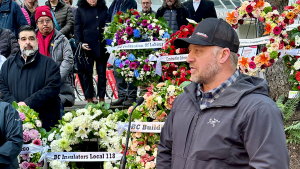An architectural expert wants a rethink of the technological transformation of the urban landscape.
Matthew Claudel, the head of civic innovation at the Massachusetts Institute of Technology’s Design X office, was the architectural keynote speaker at Buildex Vancouver.
His talk, Civic Innovation: Our Futures with City and Technology, looked at the intersection of urban planning and technological change and how both sides can push progress forward.
The city was transformed by the automobile, Claudel said, but it was a change that spanned decades. The smartphone is again changing the urban landscape, but at a much faster pace.
Claudel also pointed to companies such as Airbnb and WeWork as turning the city into a consumer product or “city as a service.”
These new technologies are growing exponentially and are funded with substantial amounts of venture capital but can exacerbate current social inequality.
“A lot of technologies are shaping urban experiences, and I think they offer a lot of opportunities for thinking differently about cities and urban spaces. But very often those tools of engagement are not extending to all residents in a city,” Claudel said.
He pointed to the Southern State Parkway bridges in New York, designed by urban planner Robert Moses, as too short for buses from the inner city to travel to outlying beaches as a previous example of city design enforcing social inequality.
“These apps and services are a far cry from the Parkway Bridges, but are arguably more impactful,” Claudel said.
Amazon Prime’s introduction of same-day delivery for Prime customers in certain Boston neighbourhoods is an example of the new use of software to create a new form of infrastructure, Claudel said.
But Roxbury, a disadvantaged neighbourhood surrounded by the other neighbourhoods in the program, could not access same-day Prime deliveries and it is an area where retail service was already sub-par.
“Roxbury is one of the least wealthy neighbourhoods in Boston and continues to be, so I find it problematic that Amazon didn’t launch the service uniformly in the city,” he said. “Of course, there can be claims that it was calculation of member density or proximity to warehouses, but I think that elides the human element of what these technologies can do in cities and also what they should do.”
Bird, a ride-sharing scooter service, is another example of new technology reinforcing inequality.
Scooters are aspirational and aimed at young technology workers but the way they get repositioned and recharged relies on those who aren’t as economically well off, Claudel said.
“These technologies have social systems embedded in them. They’re designed to be scalable and efficient, but that’s not what a city is,” he said.
Claudel recently worked with the City of Boston on a project called Beta Blocks which aimed to match technology with a neighbourhood’s needs and concentrated on a single city block to effect change.
By creating a mission statement and matching technology to it, then running public experiments with the technology and obtaining feedback from residents as well as collecting data, you can keep residents at the centre of design without cutting out government from the process, he said.
“At the block level, we can really start to experiment and interact with technology joyfully and think about what that could mean for the design process. Right now, as a designer, if I come up with a new system, it’s very difficult for me to find ways of deploying it in ways that are productive for my design process,” Claudel said.
Tools can be built at the block level that are both qualitative, quantitative and embedded in the design process, he added.
“And ultimately we can welcome anyone who lives in a city to have an opinion of how the city looks, feels and is experienced.”
Claudel also pointed to the Google Sidewalk Labs project in Toronto as successful in that it pushed data and design issues to the forefront of discussion.
“It’s incredibly important to spark civic imagination. You want people to get involved,” he said.
He also said shifting attitudes towards the technology sector may affect future urban planning.
“We are starting to be much more critical about technology and about the ways technology is delivering the things that define our life. There’s starting to be a lot more criticism and whistleblowing around this stuff. I think it’s incredibly important, and we need to focus on upping our technical literacy and our watchfulness in thinking about technology,” Claudel said.
“But I also think being strictly confrontational isn’t the way out. We can’t just whistleblow left and right. I think it’s important to show alternatives and to work towards creating them because ultimately no-one is doing this because they have any bad intention…I think it’s just a matter of not having alternatives, so we should be creating them.”











Recent Comments
comments for this post are closed